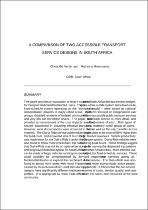 ResearchSpace
ResearchSpace
Menu-based service access and delivery pattern: Towards achieving equatable access to digital services
JavaScript is disabled for your browser. Some features of this site may not work without it.
- ResearchSpace
- →
- Research Publications/Outputs
- →
- Conference Publications
- →
- View Item
| dc.contributor.author |
Makitla, I

|
|
| dc.date.accessioned | 2016-05-16T10:10:28Z | |
| dc.date.available | 2016-05-16T10:10:28Z | |
| dc.date.issued | 2014-11 | |
| dc.identifier.citation | Makitla I. 2014. Menu-based service access and delivery pattern: Towards achieving equatable access to digital services. In: Second International Conference on Advances in Computing, Communication and Information Technology - CCIT 2014, University of Birmingham, UK, 16-17 November 2014, pp 5pp | en_US |
| dc.identifier.uri | http://www.seekdl.org/conferences_page_papers.php?confid=180&page=25&#seekdl | |
| dc.identifier.uri | http://hdl.handle.net/10204/8528 | |
| dc.description | Copyright: 2014 IRED | en_US |
| dc.description.abstract | The proliferation of mobile phones in developing countries such as South Africa has been revolutionary. This might have sufficed to address the issues of digital divide but not the digital difference. The latter means that not all these mobile phones have equal technological capabilities and this in turn has impact on the nature of the functionality that the mobile phone affords to its user. The basic capability of a mobile phone is the ability to process and display textual information. This capability is used in basic service such as Short Message Service (SMS) as well as Unstructured Supplementary Service Data (USSD). There is a need for a service access and delivery pattern that can facilitate the delivery of services using common-lowest denominator in terms of technological capabilities of mobile phones. This paper describes the conceptualization and reference implementation of a menu-based service access and delivery pattern. The reference implementation has demonstrated that through the menu-based pattern, the same content traditionally accessible only to Smartphones can be made available to low-end mobile phones as well. | en_US |
| dc.language.iso | en | en_US |
| dc.publisher | IRED | en_US |
| dc.relation.ispartofseries | Workflow;13735 | |
| dc.subject | Mobile phones | en_US |
| dc.subject | Digital services | en_US |
| dc.subject | Short Message Service | en_US |
| dc.subject | SMS | en_US |
| dc.subject | Unstructured Supplementary Service Data | en_US |
| dc.subject | USSD | en_US |
| dc.subject | Smartphones | en_US |
| dc.title | Menu-based service access and delivery pattern: Towards achieving equatable access to digital services | en_US |
| dc.type | Conference Presentation | en_US |
| dc.identifier.apacitation | Makitla, I. (2014). Menu-based service access and delivery pattern: Towards achieving equatable access to digital services. IRED. http://hdl.handle.net/10204/8528 | en_ZA |
| dc.identifier.chicagocitation | Makitla, I. "Menu-based service access and delivery pattern: Towards achieving equatable access to digital services." (2014): http://hdl.handle.net/10204/8528 | en_ZA |
| dc.identifier.vancouvercitation | Makitla I, Menu-based service access and delivery pattern: Towards achieving equatable access to digital services; IRED; 2014. http://hdl.handle.net/10204/8528 . | en_ZA |
| dc.identifier.ris | TY - Conference Presentation AU - Makitla, I AB - The proliferation of mobile phones in developing countries such as South Africa has been revolutionary. This might have sufficed to address the issues of digital divide but not the digital difference. The latter means that not all these mobile phones have equal technological capabilities and this in turn has impact on the nature of the functionality that the mobile phone affords to its user. The basic capability of a mobile phone is the ability to process and display textual information. This capability is used in basic service such as Short Message Service (SMS) as well as Unstructured Supplementary Service Data (USSD). There is a need for a service access and delivery pattern that can facilitate the delivery of services using common-lowest denominator in terms of technological capabilities of mobile phones. This paper describes the conceptualization and reference implementation of a menu-based service access and delivery pattern. The reference implementation has demonstrated that through the menu-based pattern, the same content traditionally accessible only to Smartphones can be made available to low-end mobile phones as well. DA - 2014-11 DB - ResearchSpace DP - CSIR KW - Mobile phones KW - Digital services KW - Short Message Service KW - SMS KW - Unstructured Supplementary Service Data KW - USSD KW - Smartphones LK - https://researchspace.csir.co.za PY - 2014 T1 - Menu-based service access and delivery pattern: Towards achieving equatable access to digital services TI - Menu-based service access and delivery pattern: Towards achieving equatable access to digital services UR - http://hdl.handle.net/10204/8528 ER - | en_ZA |








